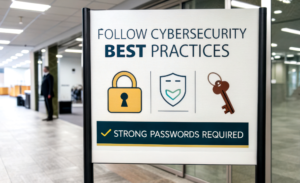Blog
How a weak password helped hackers destroy a 158-year-old business
One password. That is believed to be all it took for a ransomware gang to dismantle a company with a 158-year legacy and leave 700 people without a job. The story of Northamptonshire-based KNP Logistics, which operated the well-known Knights of Old haulage brand, is a sobering lesson in the brutal reality of modern cybercrime.
KNP’s director, Paul Abbott, is now haunted by the knowledge of how the attack likely began, but says he hasn’t told the employee whose compromised password led to the company’s destruction. “Would you want to know if it was you?” he asks.
His question hangs in the air, a stark reminder of the human cost behind the technical details of a data breach. This wasn’t a faceless corporation that suffered; it was a team of people whose livelihoods were wiped out in an instant.
The Anatomy of an Attack
The perpetrators, a gang known as Akira, gained access to KNP’s computer systems by guessing an employee’s password. Once inside, they executed their crippling strategy: they encrypted the company’s data and locked its internal systems, bringing the entire operation to a grinding halt.
The ransom note they left was chillingly detached. “If you’re reading this it means the internal infrastructure of your company is fully or partially dead…Let’s keep all the tears and resentment to ourselves and try to build a constructive dialogue,” it read.
The hackers never named a price, but a specialist negotiation firm estimated the demand could be as high as £5 million. KNP didn’t have that kind of money. With no way to pay and no way to recover their data, the business was lost.
A National Threat, Affecting Everyone
While the scale of KNP’s collapse is shocking, the attack itself is far from unique. The National Crime Agency (NCA) now deals with 35-40 such incidents a week – almost double the number from two years ago. Suzanne Grimmer, who heads the NCA’s cybercrime team, predicts this will be the “worst year on record for ransomware attacks in the UK.”
It’s a threat that cuts across all sectors. In recent months, household names like M&S, Co-op, and Harrods have been targeted. Co-op’s chief executive confirmed that the data of all 6.5 million of its members had been stolen. The criminals are not discerning; they are simply relentless.
Worryingly, the barrier to entry for these crimes is falling. Hackers no longer need to be technical wizards. They can buy ransomware software on the dark web and use simple tactics like “blagging” – ringing up an IT helpdesk and tricking staff into granting them access. As one NCA director noted, a new generation of criminals is honing their skills in online gaming forums and turning them on businesses.
The False Security of “Good Enough”
Perhaps the most critical lesson from the KNP disaster is that their IT approach was not one of negligence. The company stated its systems complied with industry standards, and crucially, it had taken out insurance against a cyber-attack.
They thought they were covered. They were wrong.
This is the dangerous gap where thousands of UK businesses now operate: believing that standard IT support and an insurance policy are a sufficient shield. But insurance can’t restore your data. It can’t win back customer trust. And it often cannot cover the full, devastating cost of a business that can no longer operate.
After his ordeal, KNP’s director Paul Abbott suggested that companies should have to prove they have up-to-date IT protection – a kind of “cyber-MOT”.
Moving Beyond Prevention to True Resilience
At Covenco, we believe this concept of a “cyber-MOT” is essential. The focus must shift from prevention alone to provable, tested resilience. The reality is that determined criminals will often find a way in. The single most important question is: what happens next?
This is where a strategic disaster recovery plan moves beyond a tick-box exercise. It is a live, functioning solution that ensures if the worst happens, you can:
- Isolate the compromised systems to stop the attack from spreading.
- Bypass the encrypted data by activating clean, isolated, and rapidly accessible backups.
- Restore full operations in a matter of hours or days, not the weeks or months that would sink a business.
When you have the proven ability to recover, the power shifts. The hackers’ ransom demand becomes irrelevant because you do not need them to get your data back. You are not a victim facing an impossible choice; you are an organisation executing a pre-planned response.
Don’t let your company’s legacy rest on the strength of a single password. Contact us today for a no-obligation review of your current recovery strategy and learn how you can build a truly resilient business.
If you’re unsure where to start, or would like an informal chat about your current security posture, our team is here to help.
